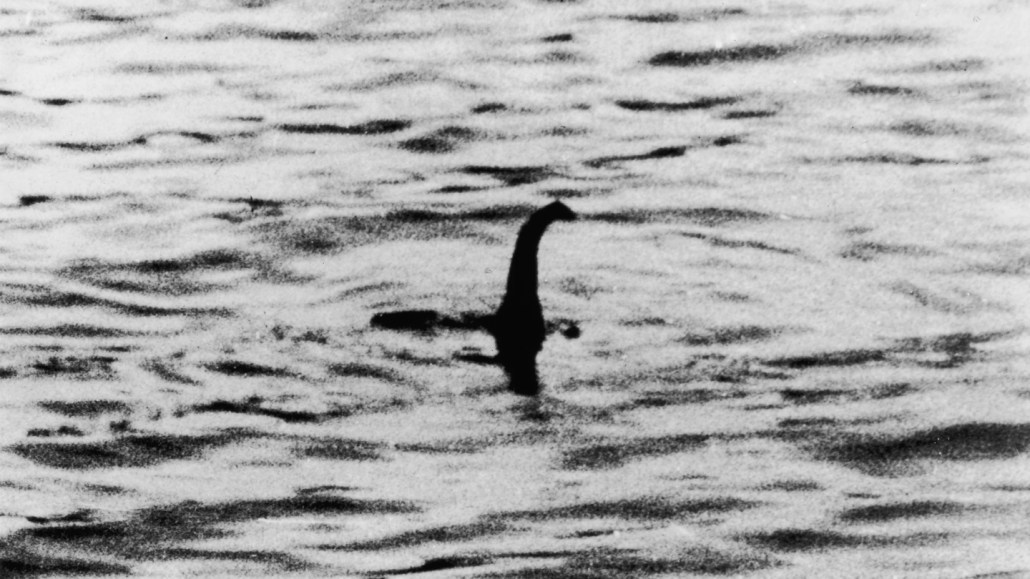
The existence of Nessie, shown in a 1934 photograph that turned out to be a hoax, probably can't be explained by a giant eel living in Loch Ness, a new study suggests.
Keystone/Stringer/Hulton Archive/Getty Images
By Meghan Rosen
- More than 2 years ago
Read another version of this article at Science News Explores
There were drones, there were boats. There were spotters on land and a hydrophone listening for suspicious sounds underwater. In what may have been the biggest search of its kind in 50 years, crowds of people gathered this summer in Scotland to hunt for any sign of a legendary creature: the Loch Ness Monster.
Nearly 6,000 kilometers away, data scientist Floe Foxon emailed the event’s organizers and wished them good luck. “I’m sure it’s going to be a fun weekend,” he said. Foxon wasn’t joining them, but from his home office in Pittsburgh, he has examined Nessie’s lore in his own way — with statistics.
In July, Foxon published a study on the probability of finding a giant eel in the loch, one of many hypotheses for sightings of the storied sea monster. The answer: Essentially zero. Even the chances of finding a 1-meter-long eel are low, about 1 in 50,000, Foxon reported in JMIRx Bio. But once you get much longer than that — into monster-sized eel territory — the probability plummets.
But don’t call Foxon a myth buster or a debunker. “Absolutely not,” he says. “I think you should approach these things with an open mind and let the data influence your decision-making.”
Though monsters have captured Foxon’s imagination, his background is in physics, and by day, he’s a data analyst for a health consulting firm. In his free time, he flits through far-flung fields of science, including astronomy, paleontology and cryptology, the study of ciphers. “When you learn data science,” Foxon says, “you find that it can be applied to more or less anything.” Even monsters.
For his Nessie study, Foxon analyzed the mass distribution of eels caught in Loch Ness and other freshwater bodies in Europe. He converted that data to eel length and then calculated the odds of finding eels of different sizes. And in a separate monster study posted online July 20 at biorXiv.org, Foxon looked at data on Big Foot sightings and black bear populations across the United States and Canada. As the number of black bears in a region goes up, Bigfoot sightings tend to increase as well, he found. That doesn’t tell you whether Bigfoot is real, though, Foxon says. “You can’t answer that sort of question without a specimen.” Instead, he thinks about it from a probability standpoint. If you think you’ve seen a sasquatch, he says, it’s probably just a bear.
But people claiming glimpses of Bigfoot or other extraordinary beasts probably aren’t hoaxers, Foxon says. “Most people are very earnest and honest about having an experience that they personally cannot explain.” He thinks scientists should listen to them and take them seriously.

Off the top of his head, Foxon can rattle off the names of supernatural attractions he’s visited around the world, from a museum of curiosities in London to the Flatwoods Monster Museum in Sutton, W. Va. He’s even been boating on Loch Ness (though no sign of Nessie).
Foxon considers his study of sea monsters, sasquatches and other mythical beings folk zoology. He describes the field as the intersection between zoology and indigenous knowledge of animals in folklore. Though Foxon’s work has roots in cryptozoology, which once used the tools of science to investigate mysterious animals, that field has since been “overrun by a lot of pseudoscience,” he says.
It’s not so much the monsters that pushed the field to the fringe, though. Foxon, for instance, investigates all sorts of cryptic creatures, including giant snakes and a hypothetical aquatic animal dubbed Champy, reported to live in North America’s Lake Champlain. But his quest for answers takes a strictly scientific tack that relies on established mathematical methods.
“It’s not what you study, it’s how you study it,” says Charles Paxton, a statistician and fish biologist at the University of St. Andrews in Scotland who has published papers on the Loch Ness Monster. Still, when people find out what Paxton studies, some assume he’s a pseudoscientist. “That’s quite frustrating, actually,” he says. “The methods of science can be more widely used than people might think.”
Foxon’s latest study, posted online August 8 at biorxiv.org, uses a statistical method to examine eyewitness sightings of a long extinct bird, the New Zealand moa (Dinornithiformes). Though scientists think the ostrichlike bird went extinct hundreds of years ago, people have reported seeing moa as recently as the 1990s. In an analysis that factored in the reliability of 97 separate moa sightings, Foxon estimated that moa probably were extinct by 1770.
“I’m greatly disappointed by all of my findings,” Foxon says with a laugh. “I really wish that there was a giant eel in Loch Ness,” or a hairy apelike monster in North America’s woods or moa living in modern times, he says. But “there seems to be a very, very low probability.”






